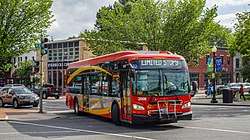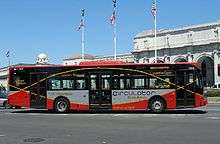DC Circulator
The DC Circulator is a bus system in Washington, D.C. The District of Columbia Department of Transportation, the Washington Metropolitan Area Transit Authority, and DC Surface Transit operate the service in a public-private partnership with RATP Dev, although it has been proposed that the District of Columbia Department of Transportation operate the Circulator directly.[3]
 A DC Circulator bus at Eastern Market in June 2018. | |
| Founded | 2005[1] |
|---|---|
| Service area | Downtown, Washington, D.C. |
| Service type | Downtown circulator |
| Routes |
|
| Fleet | 81 |
| Daily ridership | 18,800 (Q2 2016)[2] |
| Annual ridership | 5.4 million (FY2016)[1] |
| Fuel type | Diesel, Diesel-electric Hybrid, Electric bus |
| Operator | RATP Dev |
| Partners |
|
| Website | dccirculator |
The DC Circulator buses are similar to shuttle buses since they operate on a predictable fixed route and schedule, and run between the city's main attractions and some of the more popular neighborhoods for visitors. The service began in 2005, and passengers increased as the routes grew from two to five. Ridership peaked in 2011, and has decreased since then. The top month was July 2011, with 546,000 riders; the busiest month in 2014 was also July, with 470,000 riders.[4] The subsidy per rider is unusually high; in 2016, it averaged $3.32.[1]
The fare per ride is $1.00.[5]
History
The concept of a separate downtown bus was included in a 1997 report by the National Capital Planning Commission (NCPC). The report called for "a simple, inexpensive, and easily navigable surface transit system that complements Metrobus and Metrorail."[1] The next year, representatives of the Commission, the District of Columbia Department of Transportation, the Washington Metropolitan Area Transit Authority, and the Downtown D.C. business improvement district met to plan what would become the Circulator.[6]
After selecting First Transit as the system operator, the DC Circulator started service in July 2005 with two routes: one along K Street from Union Station to Georgetown, and a second from the Walter E. Washington Convention Center to the Southwest Waterfront.[6]
Additional routes were later added to serve the National Mall (2006), the 14th Street Corridor (2009), the Washington Navy Yard (2009), Rosslyn to Dupont Circle (2010), and the Skyland Town Center development in Southeast Washington (2011).[1] The two lines that served the National Mall and the Southwest Waterfront were discontinued in 2011 due to low ridership and redundant service.[7][8] The National Mall route was reinstated on June 15, 2015. The route is operated in collaboration with the National Park Service.[9]
A report released in March 2011 calls for developing better routes to replace those that had served the National Mall and Southwest Waterfront, and adding new service to the U Street Corridor, portions of Upper Northwest, and neighborhoods east of the Anacostia River.[1]
In 2018, RATP Dev replaced First Transit as the operator of the Circulator.[10]
From February 2019 until October 2019, DC Circulator rides were free under Mayor Bowser Fair Shot initiative.[11][12] However the $1 fare was reinstated due to increased ridership. However some city officials are looking into reinstating the free rides.[13][14]
Accidents
On April 18, 2007, a driver of a bus was off-duty and had left the bus to attend to other business. While he was out of the bus, the bus rolled back and crashed into a Georgetown University building. One woman was injured.[15]
Routes
The DC Circulator has six lines operating at 10-minute intervals.[16]
Georgetown – Union Station
The east-west line connects Georgetown with Union Station and operates primarily along Wisconsin Avenue, K Street, and Massachusetts Avenue. Eastbound, the bus starts on Wisconsin Avenue at Whitehaven Street in Georgetown. Westbound, the route starts in the bus level of the Union Station parking garage.[16]
Woodley Park – Adams Morgan – McPherson Square Metro
This line operates between Woodley Park, Adams Morgan, and McPherson Square via the 14th Street Corridor.[16] Part of this route replaced the discontinued Metrobus 98 route.[17]
Rosslyn – Georgetown – Dupont
This line operates from Dupont Circle primarily via M Street through Georgetown and travels over the Key Bridge to Rosslyn.[16] This route replaced the former Georgetown Metro Connection "blue bus."[18]
Eastern Market – L’Enfant Plaza
This line connects Eastern Market and L'Enfant Plaza through Navy Yard & the DC Wharf District.[19]
Congress Heights – Union Station via Barracks Row
This line operates from the Congress Heights and Union Station east of the Anacostia River via Barracks Row on Capitol Hill.[16] This route replaced the discontinued Metrobus 94 line.[20]
National Mall Route
This 15-stop loop line operates from Union Station to most of the major attractions on or near the Mall, including ones that are at some distance from Metro stations, such as the Lincoln, Jefferson, World War II, FDR, and Martin Luther King. Jr. memorials.[21]
Seasonal Routes
Zoo Express Line
This line operates from Woodley Park station to Smithsonian National Zoo without having to walk, deal with traffic, and expensive parking fees during the summer seasons. The service first run operated between May 4, 2019 and September 30, 2019. DC Circulator plans on operating the line again during summer seasons.[22]
Former routes
Smithsonian – National Gallery of Art
Until 2011 this line ran only on summer weekends, serving the National Mall in a loop along Constitution Avenue, 1st Street NE/SE, Independence Avenue, and 17th Street NW/SW.[8] The line was replaced by the more extensive National Mall route in June 2015.[9]
Convention Center – SW Waterfront
A north-south line connected the Washington Convention Center with the Southwest Waterfront and operated primarily along 7th and 9th streets, which have bus lanes. The service was eliminated on September 25, 2011 due to low ridership. A new Metrobus route, 74, was opened on September 23, 2011 along the 7th Street corridor between the Washington Convention Center and the Waterfront neighborhood, replacing the Circulator line and the eliminated portion of Metrobus Routes 70 and 71 from Pennsylvania Avenue to the South. The 74 bus costs more to ride and offers less frequent service, but the District officials said the ridership on the Circulator was too low to continue it.[7]
Potomac Ave Metro – Skyland via Barracks Row
This line operated from the Potomac Avenue Metro station and Skyland Town Center east of the Anacostia River via Barracks Row on Capitol Hill.[16] It was replaced by the Congress Heights – Union Station route on June 24, 2018 replacing Metrobus Route 94.
Union Station – Navy Yard Metro
This line connected Union Station and Navy Yard through Capitol Hill, with extended service on Washington Nationals game days.[16] This route was replaced by the Eastern Market – L’Enfant Plaza route on June 24, 2018. Also this route replaced the discontinued Metrobus N22 line.
Fleet
| Image | Builder | Model | Length | Year | Fleet Number | Fuel | Powertrain (Engine/Transmission) | Notes |
|---|---|---|---|---|---|---|---|---|
 |
Van Hool | A300K | 30 ft (9.144 m) | 2009 | 1130-1143 (14 buses) |
Diesel |
|
|
 |
New Flyer Industries | XDE40 | 40 ft (12.19 m) | 2014–2015 | 2001-2018 (18 buses) |
Diesel-electric Hybrid |
|
|
 |
XD40[23] | 40 ft (12.19 m) | 2016 | 2101-2126 (26 buses) |
Diesel |
|
| |
 |
Proterra | BE40 Catalyst E2[24] | 40 ft (12.19 m) | 2017 | 3001-3014 (14 buses) |
Battery electric |
|
|
Retired Fleet
| Image | Builder | Model | Length | Year | Fleet Number | Powertrain (Engine/Transmission) | Year Retired | Notes |
|---|---|---|---|---|---|---|---|---|
 |
Van Hool | A330 | 40 ft (12.19 m) | 2003–2004 | 1101-1129 (29 buses) |
|
2018 |
|
 |
A300L | 40 ft (12.19 m) | 2010 | 1144-1149 (6 buses) |
|
| ||
References
- "DC Circulator 2017 Transit Development Plan: Draft" (PDF). District of Columbia Department of Transportation. September 2017. Retrieved May 14, 2018.
- "Transit Ridership Report Second Quarter 2016" (pdf). American Public Transportation Association. August 22, 2016. Retrieved November 14, 2016.
- "Bus drivers, allies make a case for putting D.C. Circulator under city control". The Washington Post. May 14, 2018. Retrieved May 14, 2018.
- "Performance Metric - Ridership".
- "DC Circulator".
- "DC Circulator". Downtown DC BID. Retrieved December 12, 2011.
- "DDOT to Implement Changes to Existing Circulator Service". District of Columbia Department of Transportation. Archived from the original on June 11, 2012. Retrieved December 12, 2011.
- "D.C. Circulator bus route on National Mall ends". TBD. April 1, 2011. Archived from the original on May 23, 2013. Retrieved December 12, 2011.
- "District to Begin DC Circulator National Mall Route Bus Service". District of Columbia Department of Transportation. Archived from the original on February 1, 2017. Retrieved June 17, 2015.
- Lazo, Luz. "D.C. Circulator operations contract going to a new provider". Washington Post. Retrieved October 17, 2018.
- Rogger, Caitlin. "The Circulator is now free. Why just the Circulator? It's complicated". Greater Greater Washington. Retrieved April 23, 2020.
- Carrasco, Maria. "DC Circulator Bus Rides Will Be Free Indefinitely". NBC4 Washington. Retrieved April 23, 2020.
- Kaplan, Sophie. "DC Circulator to end free rides, charge $1 fare again". The Washington Times. Retrieved April 23, 2020.
- Giambrone, Andrew (May 15, 2019). "Free D.C. Circulator service scrapped in initial budget vote but eastward expansion preserved". Curbed DC. Retrieved April 23, 2020.
- "Bus Hits Georgetown Building". April 18, 2007. Archived from the original on February 6, 2018. Retrieved May 14, 2018.
- "Circulator Map and Information Guide". DC Circulator. Retrieved May 14, 2018.
- "Metrobus Routes 98, N22 being replaced by DC Circulator" (Press release). Washington Metropolitan Area Transit Authority. March 27, 2009. Retrieved December 20, 2009.
- "DC Circulator Expansion Continues". DDOT. Archived from the original on February 28, 2012. Retrieved May 14, 2018.
- "DC Circulator Final 2018 Service Changes". DDOT. June 24, 2018. Retrieved June 23, 2018.
- "DC Circulator Final 2018 Service Changes". DDOT. June 24, 2018. Retrieved June 23, 2018.
- "DC Circulator National Mall Route Service Map". DC Circulator. Retrieved May 14, 2018.
- "Convenient Bus Rides to the National Zoo in DC". dccirculator.com. Retrieved July 25, 2019.
- "DC Government Awards New Flyer a Contract for 26 Clean Diesel Buses". newflyer.com. New Flyer. August 1, 2017. Retrieved August 1, 2017.
- "Proposed task order cooperative agreement with Proterra, Inc". dccouncil.us. council of the district of columbia. May 25, 2017. Retrieved July 18, 2017.